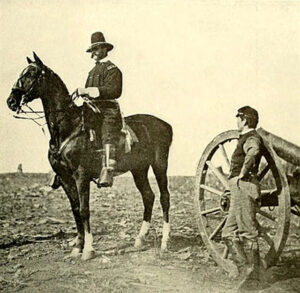A BGES Civil War Field University Program
With Len Riedel and Wade Sokolosky
January 15-19, 2025; from Norfolk, VA
 The American Civil War was a hard and bloody affair. The killing fields and legendary reputations of household names such as Lee and Grant, Farragut and Porter, and places like Antietam, Chickamauga, Gettysburg, Atlanta, and Petersburg—as well as Fort Donelson and Mobile Bay—populate the history books. But before these great battles, Roanoke Island, Fort Macon, Ocean View, Dam #1, and Williamsburg presented an existential threat to the early Confederacy.
The American Civil War was a hard and bloody affair. The killing fields and legendary reputations of household names such as Lee and Grant, Farragut and Porter, and places like Antietam, Chickamauga, Gettysburg, Atlanta, and Petersburg—as well as Fort Donelson and Mobile Bay—populate the history books. But before these great battles, Roanoke Island, Fort Macon, Ocean View, Dam #1, and Williamsburg presented an existential threat to the early Confederacy.
There have been tours of the Outer Banks, eastern North Carolina, and the Virginia Peninsula, but none have connected the two operations and evaluated their impact on the early strategies of Lincoln and Davis. This one will—it is a unique program, never before offered in BGES’s 31-year history. Don’t miss it!
Itinerary
Wednesday, January 15, 2025
Meet at 6 p.m. at the Doubletree Hotel in Norfolk, where your historians, Len Riedel and Wade Sokolosky, will provide a detailed overview of the events leading to Burnside’s deployment and expedition to the Outer Banks of North Carolina, along with its subsequent operations in eastern North Carolina.
We will break in time for you to get dinner on your own. Hotel is included.
Thursday, January 16, 2025
The capture of the Gosport Shipyard gave the new Confederacy a world-class shipyard capable of building warships and ocean-going vessels of commerce. It is also the birthplace of the CSS Virginia. We start today at 0830 with a visit to the 18th-century Fort Norfolk. Authorized in the earliest days of the United States, it played a key role in the opening stages of the Civil War. From there, we will cross the Elizabeth River to visit the Portsmouth Naval Shipyard Museum. Although the original Gosport Shipyard is now part of the modern shipyard that services the Atlantic Fleet, Drydock 1 still exists, though it is not accessible due to current security operations. The museum will provide insights into this critical period.
From, there we will travel to Ocean View, the site of the May 10, 1862, landing and capture of Norfolk. We will then visit historic Fort Monroe, where we will discuss Benjamin Butler’s tenure and the Confiscation Acts, which set the stage for the later Emancipation Proclamation. We then turn to Burnside’s objectives for his pending invasion of North Carolina, the assembly of the amphibious force, and how his operations in the Old North State supported Union strategic objectives on the Virginia Peninsula.
We will make a quick stop in Hampton to discuss early operations on the Peninsula, including the town’s burning in August 1861 and General Magruder’s initial defensive plans. Our final stop will be Camp Butler, where you’ll gain a clear view of the Federal area of operations in March 1862.
We will then deadhead to Washington, North Carolina, arriving at approximately 6 p.m., where we will stay for three nights. After checking into our hotel, we will head out for a group dinner.
Hotel, lunch, and dinner are included.
Friday, January 17, 2025
We begin our tour at 8 a.m. en route to Roanoke Island. In early February 1862, after several tense days battling the notorious shoals and dangerous waters off Cape Hatteras, Burnside’s amphibious force entered Pamlico Sound, preparing to commence operations to seize Roanoke Island. Despite the island’s significance in controlling two of the state’s largest sounds, Pamlico and Albemarle, authorities in Richmond failed to support Brig. Gen. Henry A. Wise’s, a former governor of Virginia, defensive strategy. After landing a force of more than 10,000 infantry unopposed, Burnside, supported by naval gunfire, makes short work of the Confederate’s feeble defenses the following day.
After lunch, we will travel to Elizabeth City and South Mills.
With Roanoke Island secure as a base, Burnside was eager to resume operations, but the Union navy first had to destroy its Confederate counterpart. Following the battle of Roanoke Island, the remnants of the Confederate “mosquito fleet” withdrew across Albemarle Sound and up the Pasquotank River toward Elizabeth City. On February 10, a Union flotilla located and successfully engaged the outgunned Confederate fleet, destroying all but two vessels, which escaped toward the safety of Norfolk. The U.S. Navy established dominance in the Albemarle and Pamlico Sounds.
We will finish the day along the Great Dismal Swamp Canal at South Mills, where Brig. Gen. Jesse L. Reno’s force of 4,000 failed to defeat a small blocking force of 400 Confederates, leaving his strategic lock intact. Reno’s withdrawal, back to his supporting naval vessels anchored off Elizabeth City, left open for the Confederacy the strategic backdoor to Norfolk via water. We will return to the hotel in Washington.
Lunch and the hotel are included, but dinner is on your own.
Saturday, January 18, 2025
Our day begins with Burnside’s March 1862 operation to seize New Bern, the state’s second-largest city, and cut the Atlantic & N.C. Railroad between Goldsboro and the port city of Morehead City. The defense of New Bern was the responsibility of Brig. Gen. Lawrence O. Branch’s 4,000 Confederate defenders, but despite the recent loss of Roanoke Island, Branch did not receive reinforcements—Confederate authorities were focused on a possible attack against Gosport Shipyard in Norfolk. In just 72 hours, Burnside showcased the value of amphibious operations, securing a decisive victory and forcing a chaotic Confederate retreat from the city. During our discussion of the battle of New Bern, we will explore the wonderfully preserved Confederate defensives, as well as key sites within the historic port city.
Following lunch, we continue to the next phase of Burnside’s coastal expedition. With the capture of New Bern, Burnside sets his sights on achieving one more “honorable victory” at Fort Macon. Here, an isolated Confederate force of 400 men, under the command of Mississippian Col. Moses J. White, endured a nearly month-long siege. We begin this operation’s next phase at Morehead City, where Brig. Gen. John G. Parke undertook the challenging task of positioning heavy siege weapons, men, and materiel at Bogue Banks.
More than a month later, after repeated demands for surrender, Burnside authorized Parke to commence the bombardment of Fort Macon. Eleven hours later, with one of the fort’s three powder magazines showing dangerous signs of an imminent breach of its 5-foot-thick masonry walls, White finally capitulated. The fall of Fort Macon on April 26 gave the Federals effective control of coastal North Carolina. Only the vulnerable port city of Wilmington remained. Would they now turn to Norfolk?
Lunch and the hotel are included, but dinner is on your own.
Sunday, January 19, 2025
The operations in North Carolina were of tremendous concern in Richmond, and Gen. Robert E. Lee saw them as closely connected to the March movement of McClellan’s Army of the Potomac to the Virginia Peninsula. This morning, we return to the Peninsula to briefly examine the events of March, April, and early May 1862. Departing at 8:15, we visit the USS Monitor Center at the Mariners’ Museum, where you can explore the informative displays at your own pace. Len will deliver a monologue on the impact of naval operations in Hampton Roads on military operations on both the Peninsula and Southside.
Following lunch on your own at the museum, we will conduct a quick five-stop tour at Dam #1, Yorktown, Lee’s Mill, Redoubt #2, and Fort Magruder.
We will return to the Doubletree Hotel in Norfolk by 4:30 p.m., where the program will conclude. By then, you will have studied a significant series of interconnected events that dominated the first year of the war in the East.
About the Faculty
 Len Riedel is a retired United States Air Force Major and the Executive Director of the Blue and Gray Education Society. He holds a Master’s Degree in History from Old Dominion University, where he focused on John Bankhead Magruder and the defense of the Virginia Peninsula. Len is the editor National Geographic’s best-selling Civil War guide, The Civil War: A Travelers Guide.
Len Riedel is a retired United States Air Force Major and the Executive Director of the Blue and Gray Education Society. He holds a Master’s Degree in History from Old Dominion University, where he focused on John Bankhead Magruder and the defense of the Virginia Peninsula. Len is the editor National Geographic’s best-selling Civil War guide, The Civil War: A Travelers Guide.
 Wade Sokolosky is a retired United States Army Colonel and an expert on military operations in eastern North Carolina. We first met Wade during his collaboration with Stephen Wise on our 2018 Eastern North Carolina program. He is the author of North Carolina’s Confederate Hospitals, 1861-1863, Volume I, and co-author, with Mark A. Smith, of “To Prepare for Sherman’s Coming”: The Battle of Wise’s Forks, March 1865, and “No Such Army Since the Days of Julius Caesar”: Sherman’s Carolinas Campaign from Fayetteville to Averasboro. His upcoming work, North Carolina’s Confederate Hospitals, 1864-1865, Volume II, is due for release in February 2025.
Wade Sokolosky is a retired United States Army Colonel and an expert on military operations in eastern North Carolina. We first met Wade during his collaboration with Stephen Wise on our 2018 Eastern North Carolina program. He is the author of North Carolina’s Confederate Hospitals, 1861-1863, Volume I, and co-author, with Mark A. Smith, of “To Prepare for Sherman’s Coming”: The Battle of Wise’s Forks, March 1865, and “No Such Army Since the Days of Julius Caesar”: Sherman’s Carolinas Campaign from Fayetteville to Averasboro. His upcoming work, North Carolina’s Confederate Hospitals, 1864-1865, Volume II, is due for release in February 2025.
Hotel Information
We will base this program out of Norfolk, Virginia. Your registration fee includes four nights’ hotel—the first night in Norfolk and three nights in Washington, North Carolina. The headquarters hotel is the Doubletree Norfolk Airport, 1500 Military Highway, Norfolk, VA 23502; 757-457-8904.
Transportation
The servicing airport is Norfolk International (ORF). Amtrak services Newport News, but the program is based on the opposite side of Hampton Roads (Chesapeake Bay).
Recommended Reading
You will receive maps that will meet your onsite requirements. The following books are suggested to enhance your readiness for the program.
- Branch, Paul. Fort Macon: A History. Charleston, SC: Nautical & Aviation Pub. Co. of America, 1999 (first edition)
- Marvel, William. Burnside. Chapel Hill, NC: The University of North Carolina Press, 1991.
- Meekins, Alex Christopher. Elizabeth City North Carolina and the Civil War A History of Battle and Occupation. Charleston: SC: The History Press, 2007.
- Rhoades, Jeffrey L. Scapegoat General, The Story of Major General Benjamin Huger. Hamden, CT: Archon Books, 1985.
- Sauers, Richard A. “A Succession of Honorable Victories” The Burnside Expedition in North Carolina. Dayton, OH: Morningside House, 1996.
- Settles, Thomas M. John Bankhead Magruder: A Military Reappraisal. Baton Rouge, LA: Louisiana State University Press, 2009.
- Shackleford, George. George Wythe Randolph and the Confederate Elite. Athens, GA: University of Georgia Press, 1988.
- White, James Edward III. New Bern and the Civil War. Charleston, SC: The History Press, 2011.
- Zatarga, Michael A. The Battle of Roanoke Island Burnside and the Fight for North Carolina. Charleston, SC: The History Press, 2016.
Registration
To register by mail or fax, download this printable registration form: Burnside’s 1862 Campaign in North Carolina.
Questions? Need more information? Please contact us.
